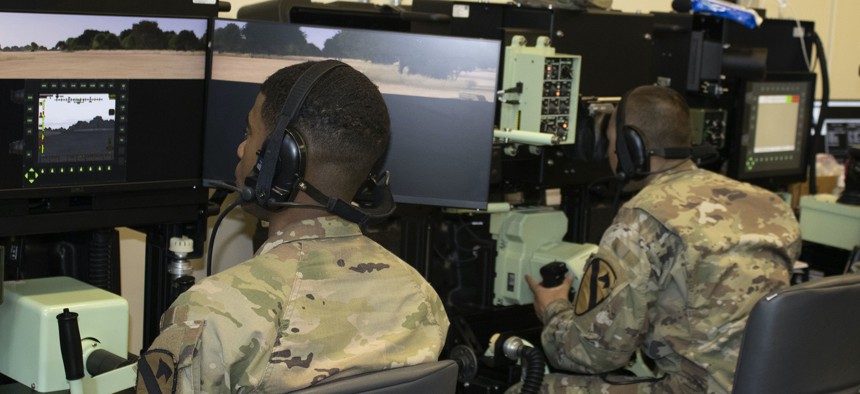SAM SKOVE

The Army’s new tools for coordinating helicopters, tanks, and infantry are on track for delivery to selected units in 2024, but are already teaching some soldiers lessons about modern warfare.
In one recent test exercise with the equipment, the Army used drones to coordinate artillery strikes against attacking Denovian soldiers, said Maj. Brandon Dotson. Denovia is a fictional country used in Army exercises that has boundaries similar to Russia’s.
“We had the whole horde coming at them and they killed everything,” said Dotson, who helped develop the program, dubbed the synthetic training environment. “We had to tell them to stop and leave something for the tanks to shoot at.”
The training exercise recalled both a decisive U.S. defeat of Russian mercenaries in Syria in 2018 and the extensive use of drone-directed artillery in Ukraine.
And the drone simulation equipment is just one part of a large package of physical training tools and software that allows soldiers from different Army branches to train together.
Right now, that package includes training simulators for the M1 Abrams tank, Bradley infantry fighting vehicle, Stryker armored fighting vehicles, and Humvees. Those simulators can communicate with several types of helicopter training simulators representing the Black Hawk, Apache, and CH-47 Chinook transport helicopter, as well as with the MQ-1C Gray Eagle and RQ-7 Shadow drones.
The system replaces clunky 1980s- and 1990s-era contractor-operated simulators for land and air warfare that have limited ability to communicate with each other.
Because of those limitations, armored units rarely got the chance to practice coordinating with aviation, said Maj. Lane Berg, a representative of the Synthetic Training Environment Program Executive Office.
The new tools also allow units to practice with drones more frequently, Dotson said, which is otherwise challenging since airspace must be closed down for drones to operate.
The Army hopes the tools’ ease of use will make soldiers more inclined to schedule training. Soldiers should be able to set up training “when they want to train, and how they want to train,” rather than relying on contractors, Berg said.
To that end, the systems are designed to be set up in 30 minutes and are shipped in hard cases for portability. Each system is also modular, allowing a Black Hawk simulator to be quickly converted into an Apache.
In a Defense One test of a Black Hawk simulator, virtual reality goggles calibrated quickly to show the dusty scrubland around Fort Cavazos, Texas. Looking down—where a pilot might expect to see their kneeboard—prompted the goggles to show a view of the real world.
The simulators are also connected via the internet, allowing a tank unit at one location to train with attack helicopters elsewhere, Dotson said.
The simulators’ connectivity also allows them to be hooked into training simulation software, with units facing off against virtual enemy forces played by Army intelligence officers. In the future, such forces may be partially controlled by automated systems.
“Being able to automate some of those behaviors is something that we want,” said Maj. Thane Keller.
The initial systems will be fielded to Ft. Cavazos; Ft. Novosel, Alabama; and Ft. Moore, Georgia.
No comments:
Post a Comment